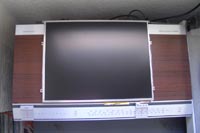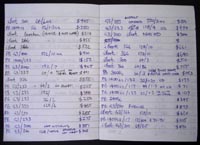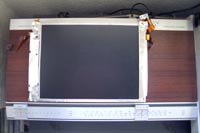You would think (or at least I would think) that if you’re buying equipment to put inside something then at some point you would measure the equipment and measure the something to check that everything fits. But that didn’t happen.
And so this happened. As you can see, the proposed screen for my MP3 player is a little bit bigger than the proposed case. A bit of a problem, but (as you may have surmised from the picture in the previous post) a problem that had a solution.
The computer I choose to mod was an Apple PowerBook Wallstreet. In 1998 Apple produced six processor variations in the Wallstreet range and three screen size variations, resulting in a wide array of possible combinations (each one practically identical – it was total product confusion). My initial Wallstreet purchase was a 266MHz G3 with a 14.1″ active matrix display; I’d done my research and this was the technological sweet spot. However, research is an odd thing and sometimes it’s difficult to establish whether you’re being empowered by knowledge or controlled by it.
To get things in perspective, here’s a page from my notebook at the time. It lists prices and specifications for various Wallstreet models available on the second hand market; there are 15 more pages like this one. Having studied up on the PowerBook Wallstreet range I was able to make expert judgements on the relative value of each model as they came to market. I was in a position to identify a ‘bargain’ and to act on it, and I did so three times; yes, I now own three Wallstreet notebooks. The specialised Wallstreet knowledge I had developed compelled me to act, to demonstrate my knowledge (even if only to myself). I managed to convince myself that buying this outdated electronic equipment at a ‘bargain’ and having it sit around for months accruing dust while it devaluated somehow equated to ‘a good investment’.
I was recently reminded (thanks to Haydn) of what David Bohm had to say about thought; that thought gives the false impression that we control it, that it does nothing but tell us the way things are. Whereas in actuality thought controls us. Bohm argues that thoughts, feelings (‘felts’), the body, and even society are all part of the same process, the same system. Our thoughts do not simply inform our actions, they construct and execute action, they are active. The idea that thought is separate from the world is itself a product of thought. By representing these PowerBook purchases to myself as ‘bargains’ I established thought as informing my actions, but in actual fact thought had already acted, and continued to act (until it got distracted and started thinking something else).
And so for about a year my ‘investments’ remained dormant (mocking me from the shelf with their ironic ‘Wallstreet’ reference). But last week the investment actually paid off because amongst my Wallstreet collection was the answer to my problem; a Wallstreet with a 12.1″ passive matrix display.
And as you can see from the pic the display fits perfectly. The screen resolution is only 800 x 600 pixels (the 14″ one is 1024 x 768) but with my simple interface program that shouldn’t be a problem. I can now get on with the mod; next step, make the case.
** Update: Much to my surprise this ‘investment’ continues to pay off. My flat was recently broken into and although in many respects this was not a good thing, it had its benefits. Among the items that disappeared was a Wallstreet PowerBook. I happen to have contents insurance and the missing Wallstreet has since been transformed into a brand new iBook. This experience has restructured my whole approach to the remaining surplus PowerBook. Instead of sitting on the shelf, it now takes up prime position on my desk while I’m away from home – it’s like a tooth awaiting the tooth fairy.



4 Comments